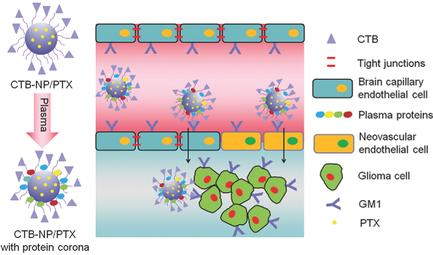当前位置:
X-MOL 学术
›
Adv. Healthcare Mater.
›
论文详情
Our official English website, www.x-mol.net, welcomes your feedback! (Note: you will need to create a separate account there.)
Cholera Toxin Subunit B Enabled Multifunctional Glioma‐Targeted Drug Delivery
Advanced Healthcare Materials ( IF 10.0 ) Pub Date : 2017-08-25 , DOI: 10.1002/adhm.201700709 Juan Guan 1 , Zui Zhang 1 , Xuefeng Hu 2 , Yang Yang 1 , Zhilan Chai 2 , Xiaoqin Liu 3 , Jican Liu 4 , Bo Gao 1 , Weiyue Lu 2 , Jun Qian 2 , Changyou Zhan 1, 2
Advanced Healthcare Materials ( IF 10.0 ) Pub Date : 2017-08-25 , DOI: 10.1002/adhm.201700709 Juan Guan 1 , Zui Zhang 1 , Xuefeng Hu 2 , Yang Yang 1 , Zhilan Chai 2 , Xiaoqin Liu 3 , Jican Liu 4 , Bo Gao 1 , Weiyue Lu 2 , Jun Qian 2 , Changyou Zhan 1, 2
Affiliation

|
Glioma is among the most formidable brain cancers due to location in the brain. Cholera toxin subunit B (CTB) is investigated to facilitate multifunctional glioma‐targeted drug delivery by targeting the glycosphingolipid GM1 expressed in the blood–brain barrier (BBB), neovasulature, and glioma cells. When modified on the surface of poly(lactic‐co‐glycolic acid) (PLGA) nanoparticles (CTB‐NPs), CTB fully retains its bioactivity after 24 h incubation in the fresh mouse plasma. The formed protein corona (PC) of CTB‐NP and plain PLGA nanoparticles (NP) after incubation in plasma is analyzed using liquid chromatography tandem massspectrometry (nano‐LC‐MS/MS). CTB modification does not alter the protein components of the formed PC, macrophage phagocytosis, or pharmacokinetic profiles. CTB‐NP can efficiently penetrate the in vitro BBB model and target glioma cells and human umbilical vascular endothelial cells. Paclitaxel is loaded in NP (NP/PTX) and CTB‐NP (CTB‐NP/PTX), and their antiglioma effects are assessed in nude mice bearing intracranial glioma. CTB‐NP/PTX can efficiently induce apoptosis of intracranial glioma cells and ablate neovasulature in vivo, resulting in significant prolongation of survival of nude mice bearing intracranial glioma (34 d) in comparison to those treated with NP/PTX (29 d), Taxol (24 d), and saline (21 d). The present study suggests a potential multifunctional glioma‐targeted drug delivery system enabled by cholera toxin subunit B.
中文翻译:

霍乱毒素亚基B启用多功能胶质瘤靶向药物递送
由于脑中的位置,神经胶质瘤是最可怕的脑癌之一。研究了霍乱毒素亚基B(CTB),通过靶向在血脑屏障(BBB),新血管和胶质瘤细胞中表达的糖鞘脂GM1来促进多功能胶质瘤靶向药物的递送。在聚乳酸-乙醇酸(PLGA)纳米颗粒(CTB-NPs)的表面上进行修饰后,在新鲜小鼠血浆中孵育24小时后,CTB可以完全保留其生物活性。使用液相色谱串联质谱(nano-LC-MS / MS)分析血浆中孵育后形成的CTB-NP蛋白质电晕(PC)和普通PLGA纳米颗粒(NP)。CTB修饰不会改变所形成PC的蛋白质成分,巨噬细胞吞噬作用或药代动力学特征。CTB-NP可以有效地穿透体外BBB模型,并靶向神经胶质瘤细胞和人脐带血管内皮细胞。紫杉醇装载在NP(NP / PTX)和CTB-NP(CTB-NP / PTX)中,并在携带颅内神经胶质瘤的裸鼠中评估其抗神经胶质瘤的作用。CTB-NP / PTX可以有效诱导颅内神经胶质瘤细胞凋亡并在体内消融新血管,与携带NP / PTX的裸鼠(29 d)相比,可显着延长患有颅内神经胶质瘤的裸鼠的生存期(34 d)。 (24 d)和生理盐水(21 d)。本研究表明,霍乱毒素亚基B可以实现一种潜在的针对神经胶质瘤的多功能药物递送系统。并在携带颅内神经胶质瘤的裸鼠中评估其抗神经胶质瘤的作用。CTB-NP / PTX可以有效诱导颅内神经胶质瘤细胞凋亡并在体内消融新血管,与携带NP / PTX的裸鼠(29 d)相比,可显着延长患有颅内神经胶质瘤的裸鼠的生存期(34 d)。 (24 d)和生理盐水(21 d)。本研究表明,霍乱毒素亚基B可以实现一种潜在的针对神经胶质瘤的多功能药物递送系统。并在携带颅内神经胶质瘤的裸鼠中评估其抗神经胶质瘤的作用。CTB-NP / PTX可有效诱导颅内神经胶质瘤细胞凋亡并在体内消融新血管,与带有NP / PTX的裸鼠(29 d)相比,可显着延长患有颅内神经胶质瘤的裸鼠的生存期(34 d)。 (24 d)和生理盐水(21 d)。本研究表明,霍乱毒素亚基B可以实现一种潜在的针对神经胶质瘤的多功能药物递送系统。
更新日期:2017-08-25
中文翻译:

霍乱毒素亚基B启用多功能胶质瘤靶向药物递送
由于脑中的位置,神经胶质瘤是最可怕的脑癌之一。研究了霍乱毒素亚基B(CTB),通过靶向在血脑屏障(BBB),新血管和胶质瘤细胞中表达的糖鞘脂GM1来促进多功能胶质瘤靶向药物的递送。在聚乳酸-乙醇酸(PLGA)纳米颗粒(CTB-NPs)的表面上进行修饰后,在新鲜小鼠血浆中孵育24小时后,CTB可以完全保留其生物活性。使用液相色谱串联质谱(nano-LC-MS / MS)分析血浆中孵育后形成的CTB-NP蛋白质电晕(PC)和普通PLGA纳米颗粒(NP)。CTB修饰不会改变所形成PC的蛋白质成分,巨噬细胞吞噬作用或药代动力学特征。CTB-NP可以有效地穿透体外BBB模型,并靶向神经胶质瘤细胞和人脐带血管内皮细胞。紫杉醇装载在NP(NP / PTX)和CTB-NP(CTB-NP / PTX)中,并在携带颅内神经胶质瘤的裸鼠中评估其抗神经胶质瘤的作用。CTB-NP / PTX可以有效诱导颅内神经胶质瘤细胞凋亡并在体内消融新血管,与携带NP / PTX的裸鼠(29 d)相比,可显着延长患有颅内神经胶质瘤的裸鼠的生存期(34 d)。 (24 d)和生理盐水(21 d)。本研究表明,霍乱毒素亚基B可以实现一种潜在的针对神经胶质瘤的多功能药物递送系统。并在携带颅内神经胶质瘤的裸鼠中评估其抗神经胶质瘤的作用。CTB-NP / PTX可以有效诱导颅内神经胶质瘤细胞凋亡并在体内消融新血管,与携带NP / PTX的裸鼠(29 d)相比,可显着延长患有颅内神经胶质瘤的裸鼠的生存期(34 d)。 (24 d)和生理盐水(21 d)。本研究表明,霍乱毒素亚基B可以实现一种潜在的针对神经胶质瘤的多功能药物递送系统。并在携带颅内神经胶质瘤的裸鼠中评估其抗神经胶质瘤的作用。CTB-NP / PTX可有效诱导颅内神经胶质瘤细胞凋亡并在体内消融新血管,与带有NP / PTX的裸鼠(29 d)相比,可显着延长患有颅内神经胶质瘤的裸鼠的生存期(34 d)。 (24 d)和生理盐水(21 d)。本研究表明,霍乱毒素亚基B可以实现一种潜在的针对神经胶质瘤的多功能药物递送系统。


























 京公网安备 11010802027423号
京公网安备 11010802027423号